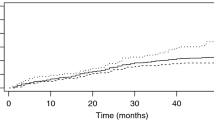Abstract
In this article, we propose an additive-multiplicative rates model for recurrent event data in the presence of a terminal event such as death. The association between recurrent and terminal events is nonparametric. For inference on the model parameters, estimating equation approaches are developed, and the asymptotic properties of the resulting estimators are established. The finite sample behavior of the proposed estimators is evaluated through simulation studies, and an application to a bladder cancer study is provided.
Similar content being viewed by others
References
Andersen PK, Gill RD (1982) Cox’s regression model for counting processes: a large sample study. Ann Stat 10: 1100–1120
Bilias Y, Gu M, Ying Z (1997) Towards a general asymptotic theory for Cox model with staggered entry. Ann Stat 25: 662–682
Byar DP (1980) The Veterans administration study of chemoprophylaxis for recurrent stage I bladder tumors: Comparisons of placebo, pyridoxine and topical thiotepa. In: Pavone-Macaluso M, Smith PH, Edsmyr F (eds) Bladder tumors and other topics in urological oncology. Plenum, New York, pp 363–370
Chang SH, Wang MC (1999) Conditional regression analysis for recurrence time data. J Am Stat Assoc 94: 1221–1230
Cheng SC, Wei LJ, Ying Z (1995) Analysis of transformation models with censored data. Biometrika 82: 835–845
Cook RJ, Lawless JF (1997) Marginal analysis of recurrent events and a terminating event. Stat Med 16: 911–924
Cook RJ, Lawless JF (2007) The statistical analysis of recurrent events. Springer, New York
Cook RJ, Lawless JF, Lakhal-Chaieb L, Lee K-A (2009) Robust estimation of mean functions and treatment effects for recurrent events under event-dependent censoring and termination: Application to skeletal complications in cancer metastatic to bone. J Am Stat Assoc 104: 60–75
Fleming TR, Harrington DP (1991) Counting processes and survival analysis. Wiley, New York
Ghosh D, Lin DY (2000) Nonparametric analysis of recurrent events and death. Biometrics 56: 554–562
Ghosh D, Lin DY (2002) Marginal regression models for recurrent and terminal events. Stat Sin 12: 663–688
Huang CY, Wang MC (2004) Joint modeling and estimation of recurrent event processes and failure time. J Am Stat Assoc 99: 1153–1165
Kalbfleisch JD, Prentice RL (2002) The statistical analysis of failure time data, 2nd edn. Wiley, New York
Liang KY, Zeger SL (1986) Longitudinal data analysis using generalized linear models. Biometrika 73: 13–22
Lin DY, Fleming TR, Wei LJ (1994) Confidence bands for survival curves under the proportional hazards model. Biometrika 81: 73–81
Lin DY, Wei LJ, Yang I, Ying Z (2000) Semiparametric regression for the mean and rate functions of recurrent events. J R Stat Soc B 62: 711–730
Lin DY, Wei LJ, Ying Z (2001) Semiparametric transformation models for point processes. J Am Stat Assoc 96: 620–628
Lin DY, Ying Z (1995) Semiparametric analysis of general additive-multiplicative hazard models for counting processes. Ann Stat 23: 1712–1734
Liu D, Schaubel DE, Kalbfleisch JD (2012) Computationally efficient marginal models for clustered recurrent event data. Biometrics 68: 637–647
Liu L, Wolfe RA, Huang X (2004) Shared frailty models for recurrent events and a terminal event. Biometrics 60: 747–756
Liu Y, Wu Y, Cai J, Zhou H (2010) Additive-multiplicative rates model for recurrent events. Lifet Data Anal 16: 353–373
Miloslavsky M, Keles S, Vander Laan MJ, Butler S (2004) Recurrent events analysis in the presence of time-dependent covariates and dependent censoring. J R Stat Soc B 66: 239–257
Nielsen GG, Gill RD, Andersen PK, Sorensen TIA (1992) A counting process approach to maximum likelihood estimation in frailty models. Scand J Stat 19: 25–43
Pan Q, Schaubel DE (2009) Flexible estimation of differences in treatment-specific recurrent event means in the presence of a terminating event. Biometrics 65: 753–761
Pepe MS, Cai J (1993) Some graphical displays and marginal regression analyses for recurrent failure times and time-dependent covariate. J Am Stat Assoc 88: 811–820
Pollard D (1990) Empirical processes: theory and applications. Institute of Mathematical Statistics, Hayward, CA
Prentice RL, Williams BJ, Peterson AV (1981) On the regression analysis of multivariate failure time data. Biometrika 68: 373–379
Rudin WB (1976) Principles of mathematical analysis, 3rd edn. McGraw-Hill, New York
Schaubel DE, Zeng D, Cai J (2006) A semiparametric additive rates model for recurrent event data. Lifet Data Anal 12: 389–406
van der Vaart AW, Wellner JA (1996) Weak convergence and empirical processes. Springer, New York
Wang MC, Qin J, Chiang CT (2001) Analyzing recurrent event data with informative censoring. J Am Stat Assoc 96: 1057–1065
Ye Y, Kalbfleisch JD, Schaubel DE (2007) Semiparametric analysis of correlated recurrent and terminal events. Biometrics 63: 78–87
Zeng D, Cai J (2010) Semiparametric additive rate model for recurrent events with informative terminal event. Biometrika 97: 699–712
Zeng D, Lin DY (2006) Efficient estimation of semiparametric transformation models for counting processes. Biometrika 93: 627–640
Zeng D, Lin DY (2007) Semiparametric transformation models with random effects for recurrent events. J Am Stat Assoc 102: 167–180
Zeng D, Lin DY (2009) Semiparametric transformation models with random effects for joint analysis of recurrent and terminal events. Biometrics 65: 746–752
Author information
Authors and Affiliations
Corresponding author
Rights and permissions
About this article
Cite this article
Sun, L., Kang, F. An additive-multiplicative rates model for recurrent event data with informative terminal event. Lifetime Data Anal 19, 117–137 (2013). https://doi.org/10.1007/s10985-012-9228-2
Received:
Accepted:
Published:
Issue Date:
DOI: https://doi.org/10.1007/s10985-012-9228-2



